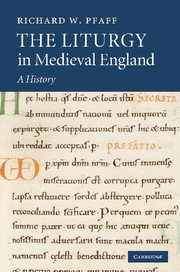Book contents
- Frontmatter
- Contents
- Preface
- Sigla and editorial conventions
- Bibliographical abbreviations
- Nicknames for manuscripts frequently referred to
- 1 Introduction
- Excursus: on sources
- 2 Early Anglo-Saxon England: a partly traceable story
- Excursus: on the terms Gregorian and Gelasian as used here
- 3 Later Anglo-Saxon: liturgy for England
- 4 The Norman Conquest: cross fertilizations
- Excursus: on method in the comparison of liturgical texts
- 5 Monastic liturgy, 1100–1215
- Excursus: on ascription of liturgical books to specific churches
- 6 Benedictine liturgy after 1215
- 7 Other monastic orders
- 8 The non-monastic religious orders: canons regular
- 9 The non-monastic religious orders: friars
- Excursus: on liturgical books from female religious houses
- 10 Old Sarum: the beginnings of Sarum Use
- 11 New Sarum and the spread of Sarum Use
- 12 Exeter: the fullness of secular liturgy
- 13 Southern England: final Sarum Use
- 14 Regional Uses and local variety
- 15 Towards the end of the story
- Index of Manuscripts
- Index of Saints
- General Index
13 - Southern England: final Sarum Use
Published online by Cambridge University Press: 20 March 2010
- Frontmatter
- Contents
- Preface
- Sigla and editorial conventions
- Bibliographical abbreviations
- Nicknames for manuscripts frequently referred to
- 1 Introduction
- Excursus: on sources
- 2 Early Anglo-Saxon England: a partly traceable story
- Excursus: on the terms Gregorian and Gelasian as used here
- 3 Later Anglo-Saxon: liturgy for England
- 4 The Norman Conquest: cross fertilizations
- Excursus: on method in the comparison of liturgical texts
- 5 Monastic liturgy, 1100–1215
- Excursus: on ascription of liturgical books to specific churches
- 6 Benedictine liturgy after 1215
- 7 Other monastic orders
- 8 The non-monastic religious orders: canons regular
- 9 The non-monastic religious orders: friars
- Excursus: on liturgical books from female religious houses
- 10 Old Sarum: the beginnings of Sarum Use
- 11 New Sarum and the spread of Sarum Use
- 12 Exeter: the fullness of secular liturgy
- 13 Southern England: final Sarum Use
- 14 Regional Uses and local variety
- 15 Towards the end of the story
- Index of Manuscripts
- Index of Saints
- General Index
Summary
At some time during the second half of the fourteenth century there appeared a fuller codification of the rubrics according to which services were to be conducted at Salisbury cathedral. A bland word like “appeared” is necessary because we know neither who is responsible for drawing this up nor by what authority (or means) it was promulgated. All that is even remotely clear is that these rubrics are mostly drawn from something called the New Ordinal – the conventional capitals, though possibly misleading, will be retained here – which seems to have been recognized as existing, with wider reference than merely to the cathedral, by the end of the century. The new rubrics are characterized by a great attention to, indeed an apparent fascination with, details of the tiniest sort. It is inevitable that we should attempt to use this New Ordinal as a prime means of understanding both the development of the Sarum rite in its final form and the extension of that rite into most of southern England; but we shall have to do so with caution, above all against being bogged down in too much of that detail.
Frere's Use of Sarum again
To begin, we have once again to take a preliminary look at the way the matter has been studied previously: a look that will of necessity recapitulate some of what has been explained in earlier chapters, particularly chapter 11. In the two-volume work entitled The Use of Sarum (1898–1901), Walter Howard Frere (on whom, see p. 10) presented documents he termed “consuetudinary,” “customary,” “ordinal,” and “tonal.”
- Type
- Chapter
- Information
- The Liturgy in Medieval EnglandA History, pp. 412 - 444Publisher: Cambridge University PressPrint publication year: 2009



